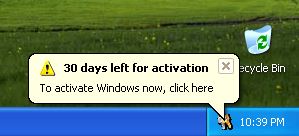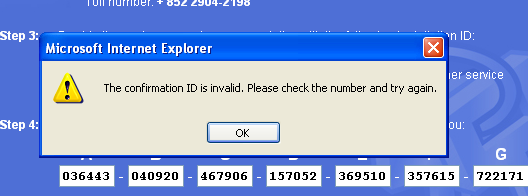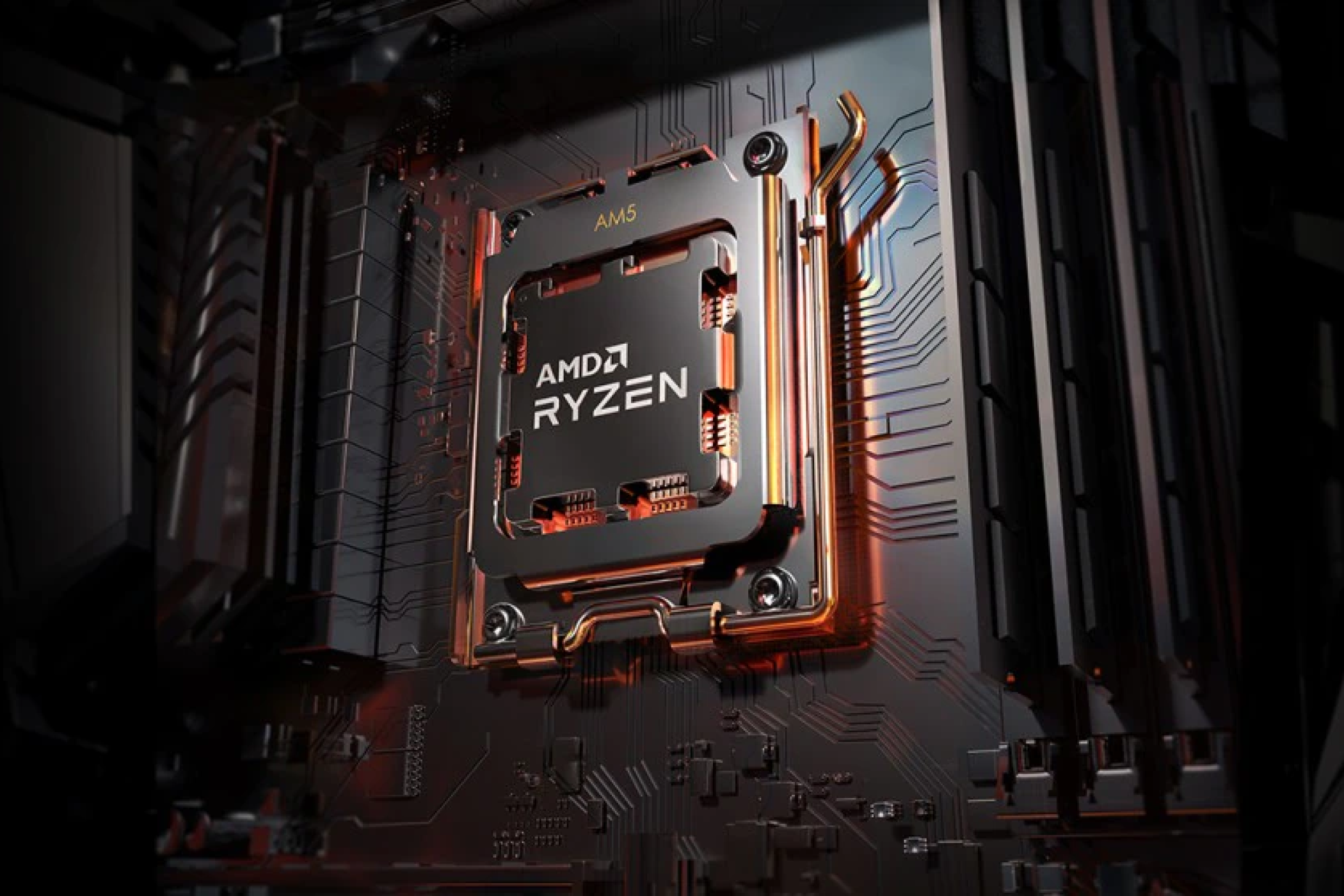
Ronald.phillips
Shared posts
NBC Accused Gene Roddenberry Of Master Manipulation In Pursuit Of Star Trek Season 3
What Is ‘Roof Ponding’ (and What Can You Do About It)?

The roof is one of the most important aspects of your home. If your roof fails you, it kicks off a domino effect of water, structural, and possession damage that makes your comfortable space uncomfortable, unattractive, and potentially dangerous if mold takes root. When it’s doing its job and keeping us dry, we tend…
SNEG re-releases some classic Raven Software PC games
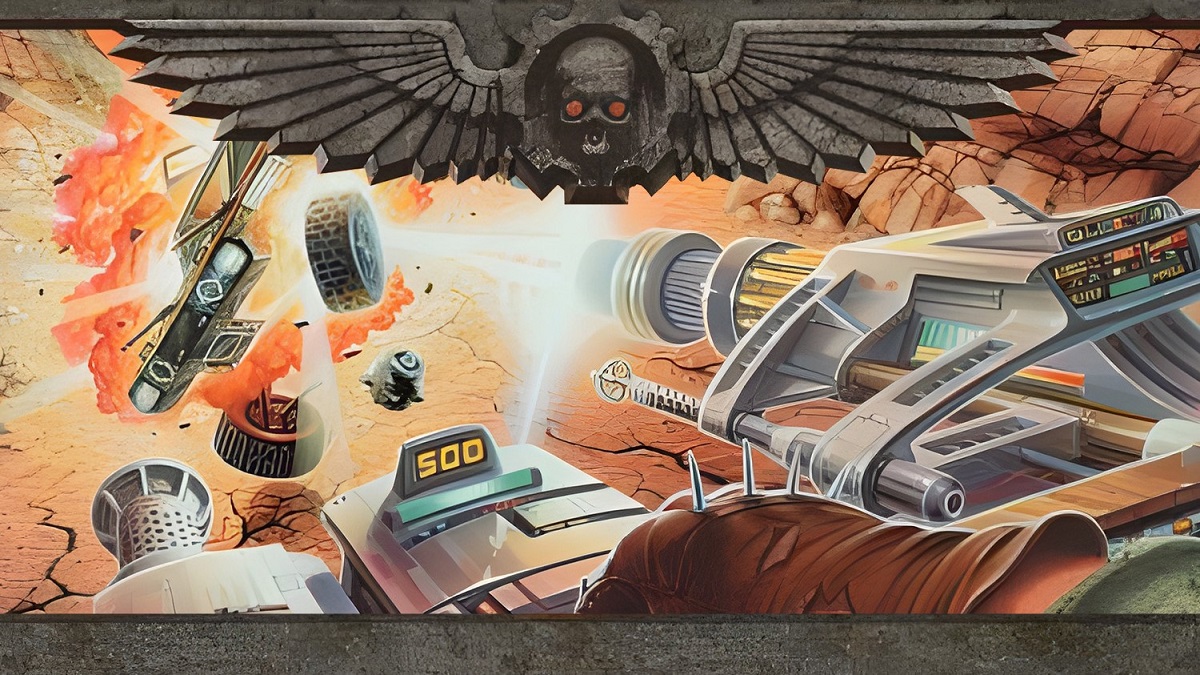
The late-century nightmare
SNEG, a company devoted to completing GOG’s manifesto of dredging up good old games, has dropped another three PC titles of yore. This time, it’s Take No Prisoners, Cyclones, and Necrodome. Those are some real ‘90s names!
All three games are from Raven Software, the company that brought us Hexen, Star Wars: Jedi Knight II: Jedi Outcast, and are now working in Activision Blizzard’s Call of Duty mines.
First up, we have Take No Prisoners. This is a 1997 top-down shooter set in the post-apocalypse. You play as Slade, a man tasked with finding some sort of crystal. It’s, oh gosh… You can just smell the 1990s on it.
https://youtu.be/uJv6lFX5QG8
Moving on, we’re at Cyclones. In this 1994 FPS, you play as Havoc, a man who is essentially Robo-Cop. It was a pretty ambitious first-person shooter, being an early title with mouse control for aiming. Once again, it looks dated, but I absolutely love early first-person shooters, so I absolutely love the look of Cyclones.
https://youtu.be/wGeWo1uoX9s
Finally, we have Necrodome. This one is a 1996 vehicular combat game. This one was right on the cusp of the big vehicular boom that started with 1995’s Twisted Metal. Good times.
https://youtu.be/uKwJd_-Y6f4
Keepers of the time capsule
All of these look like something I’d enjoy tinkering around with. While GOG has moved up in the world and become a more traditional storefront, I still love seeing people dredge up the forgotten PC games that may have been missed. SNEG was actually formed by the former senior vice president of business development at GOG, Oleg Klapovskiy. There doesn’t seem to be any bad blood there (SNEG publishes on GOG), but Klopovskiy’s favorite part of the job seems to have been digital excavation, so he backed Elena Roor to return to it.
The preservation of video games is something I’m extremely passionate about, so I’ll be keeping an eye on SNEG. My only regret in this line of work is that there isn’t enough time to play everything, but, dammit, I still try.
Cyclones, Necrodome, and Take No Prisoners are available right now on GOG and Steam.
The post SNEG re-releases some classic Raven Software PC games appeared first on Destructoid.
DFIR Core Principles
 |
| My copy of "Forensic Discovery" |
considering getting into the field. As such, I thought it might be useful to share my view of the core, foundational principles of DFIR, those basic principles I return to again and again during investigations, as well as over the course of time. For me, these principles were developed initially through a process of self-education, reading all I could from those who really stood out in in the industry. For example, consider the figure to the right...this is what pages 4 and 5 of my copy of Forensic Discovery by Farmer and Venema look like. The rest of the pages aren't much different. I also have a copy of Eoghan Casey's Handbook of Digital Forensics and Investigations, which is in similar "condition", as are several other books, including my own.
Retrieving and translating CPUID features for a vSphere VM
Xbox One Not Getting Any More 1st Party Games from Microsoft, “We’ve Moved on to Gen 9”

Pour one out for the humble Xbox One, as the console’s lifespan has finally come to an end. Well, that may be a bit dramatic, as some third-party titles will still be released on the system, but Microsoft itself has officially parted ways with its only-semi-successful Gen 8 console. During the most recent Xbox Games Showcase, all the first-party titles shown only mentioned PC and Xbox Series X/S in terms of platforms, but that could have just been a marketing thing. Sony always emphasizes the PS5 in their trailers and marketing… but then often quietly releases games on the PS4 as well. Don’t expect something similar with the XB1 going forward.
In a new interview with Axios, Xbox Game Studios boss Matt Booty stated Microsoft has “moved on to Gen 9.” And it seems he really means it -- there are currently no internal Xbox teams working on anything for Xbox One, aside from updates for long-running live-service titles like The Elder Scrolls Online. Of course, Xbox One owners can still technically get into new first-party games if they sign up for Game Pass Ultimate and play via the cloud.
The news that the Xbox One is finally being left behind may upset some still clinging to the system, but it’s likely to be a relief to many others. Given hardware shortages and the high price of next-gen consoles, the “crossgen” era, with games being released on both last and current-gen consoles, has dragged on much longer than usual. Perhaps too long, as it’s arguably limited the potential of titles that still have to design around the limitations of the XB1/PS4. Microsoft’s rival Sony has not yet committed to fully leaving the PS4 behind, but many of their upcoming games, like Marvel’s Spider-Man 2, are PS5 exclusive.
While Microsoft is leaving behind the Xbox One, don’t expect them to ditch their less powerful current-gen console Xbox Series S anytime soon. Booty has admitted getting games to work on both the Xbox Series X and S is “more work,” but internal teams have gained more experience with working around the Series S’ limitations and “sharp edges” now.
Any Xbox One owners out there? With the console’s days numbered, do you have any particularly fond memories of the system?
Saturn’s moon Enceladus could support species similar to Earth
Saturn’s moon Enceladus has phosphorous. The finding came from recently analyzed icy particles emitted from the natural satellite’s ocean plumes, detected by NASA’s Cassini spacecraft. The discovery means Enceladus has all the chemical building blocks for life as we know it on Earth. “This is the final one saying, ‘Yes, Enceladus does have all of the ingredients that typical Earth life would need to live and that the ocean there is habitable for life as we know it,” Morgan Cable, astrobiology chemist at NASA’s Jet Propulsion Laboratory, toldThe Wall Street Journal.
Cassini, which plunged to its demise in Saturn’s atmosphere in 2017, collected data by passing through Enceladus’ continually erupting geysers at its south pole and Saturn’s E ring, also containing escaped particles from the moon. Beneath its icy crust, Enceladus has a warm subsurface ocean, over 30 miles deep, enveloping the entire moon. The eruptions at its south pole spit icy particles into space, allowing research crafts like Cassini to study the ocean’s chemical makeup without taking a dip or even touching the moon’s surface.
Data from previous missions indicated the moon had all of life’s essential building blocks — carbon, hydrogen, nitrogen, oxygen and sulfur — except for phosphorous. A team of planetary scientists found nine grains containing phosphate (phosphorous bound to oxygen atoms) among around 1,000 samples initially overlooked by researchers. The tiny amount detected reflects phosphorous’ scarcity. “Of the six bioessential elements, phosphorus is by far the rarest in the cosmos,” said Frank Postberg, the study’s lead author.
Of course, Enceladus containing the requirements for life doesn’t necessarily mean life exists on the moon. “The next step is to figure out if indeed it is inhabited, and it is going to take a future mission to answer that question,” Cable said. “But this is exciting, because it makes Enceladus an even more compelling destination to go and do that kind of search.” NASA will get a chance to learn more when the Dragonfly mission heads for Saturn’s moon Titan in 2027; another proposed mission could arrive at Enceladus around 2050. In addition, the James Webb Space Telescope may help further to illuminate the chemical breakdown of Enceladus’ warm subterranean ocean.
This article originally appeared on Engadget at https://www.engadget.com/saturns-moon-enceladus-could-support-species-similar-to-earth-182535342.html?src=rssBest liquid coolers for CPUs in 2024
When planning to push the best CPU beyond its factory-set limits, you're going to require some serious cooling. Air coolers that consist of a heatsink and fan are generally good enough for standard use, but when you're looking to up clock speeds and power draw, a closed-loop all-in-one (AIO) liquid cooler is the preferred option. In this guide, we'll be taking a look at some of the best AIO liquid coolers you can buy to help take the heat away from the CPU.
Google Could End Up Losing 80% Of Its Business If The European Union Forces The Company To Divest Its Ad Business

There is no denying that Google dominates the online ad market, and this is something that has landed the company in hot water time and again. Now, European Union is expressing its concerns over how the search engine giant may have breached the antitrust laws and how its ad business should be broken up.
Google’s Ad business in danger as European Union cracks down on the search engine giant
The EU, in a lengthy post, talked about how the company has informed Google of a "preliminary view" where the European Union believes that the company has breached the antitrust rules pertaining to the ad business. The reason behind the EU's concern is that the search engine giant has been found favoring its own ads in the products, which, in return, is detrimental to the competition.
EU claims that one can see this in effect by observing how Google handles its AdX ad exchange. The DFP runs ad selection through AdX, while Google Ads and DV360 are responsible for handing over the buying tools for advertisers that are also running ads through AdX. This practice might seem simple on paper, but it results in other ad exchanges getting zero pieces of the pie and basically asserts Google's dominance even more than before.
EU's post also talked about how a "behavioural remedy" is not going to be enough in this case, and Google will be required to divest and break up its ad business. Which, of course, would allow Google's own advertising products outside the company.
The Commission preliminarily finds that, in this particular case, a behavioural remedy is likely to be ineffective to prevent the risk that Google continues such self-preferencing conducts or engages in new ones. Google is active on both sides of the market with its publisher ad server and with its ad buying tools and holds a dominant position on both ends. Furthermore, it operates the largest ad exchange. This leads to a situation of inherent conflicts of interest for Google. The Commission’s preliminary view is therefore that only the mandatory divestment by Google of part of its services would address its competition concerns.
Now, this does not entirely spell danger for the company. However, one thing that must be kept in mind is that this preliminary viewing is still something that the company should be worried about because this is not the first time they have faced scrutiny over its dominance. The company has to divest its ad business could result in the company taking a massive, massive loss because, based on several reports, it accounts for almost 80% of the business. Since Google Ads are not just stand-alone products and services but can also be found in other services provided by the company.
If this preliminary view does go into the ruling, then we will have to see how it turns out and whether or not there is a middle ground that can be reached with the EU where both parties are happy with the outcome.
Everyone seems to be losing their minds over the Windows XP Professional Key
algorithm being cracked.
But of course, how does that help me?
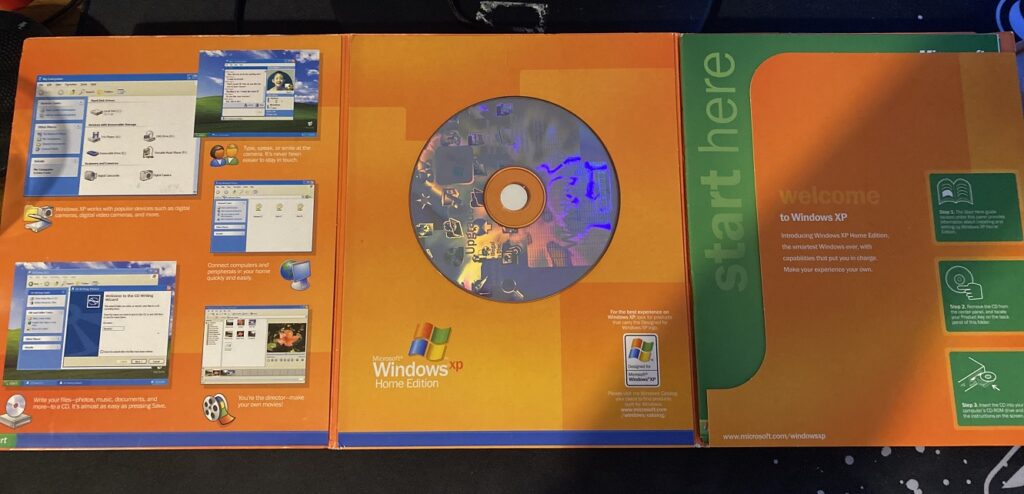
Unironically, I had purchased this for a whopping £4.68

No, really here’s the receipt. What a bargain!
Of course this is a legit copy with a legit key. But the online activation servers are all gone, and it looks like I’d have to call someone asking about my 22 year old copy of Windows, that I’ll load up and quickly forget.
Since I’m going to use QEMU, 0.90 with pcap support I thought I’d share the startup options:
set loopback=\Device\NPF_{3DF0EC5D-7FBE-46DF-ACF8-EF5D8679A473}
set vmnet1=\Device\NPF_{3BC364F4-5A15-405D-926C-C594383F0323}
qemu -m 512 -L pc-bios ^
-hda xphome.vmdk ^
-soundhw es1370 ^
-net nic,model=pcnet,macaddr=52:24:00:33:00:01 ^
-net pcap,devicename=%loopback% ^
%1 %2 %3 %4 %5 %6I had high hopes for this thing. Clearly misplaced ambitions.
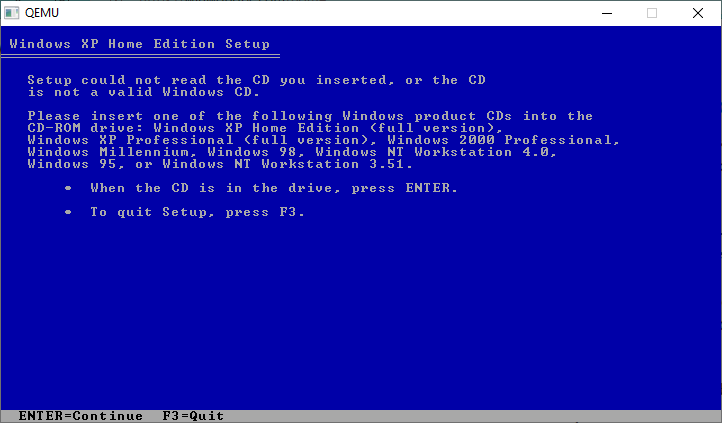
First up, it’s an upgrade version. So that means instead of installing XP I had to waste my time installing NT Workstation 3.51, then installing XP. Yuck. And of course it just want small FAT disks of the 2/4 gigabyte boundary type as it’s 1994. Not the bright future of 2002’s Windows XP.
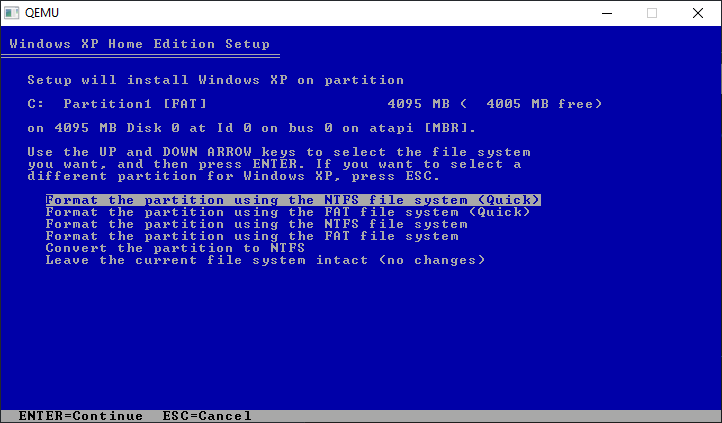
I don’t know why Qemu 0.90 has issues with XP detecting the CD-ROM drive, but yeah that sucked. I wanted to load up some more insane SNA experiments, but there is no DLC / 802.2 driver for XP Home. wow.
At least once it’s satisfied, we can format the disk as one big happy partition, and we can get on with our lives.
Installation is rather uneventful, however we are instantly reminded that we have only 30 days to go. Since we have that nasty CD-ROM issue that means shutting down, and booting back up, but with this fun program on an ISO image, xp_activate.
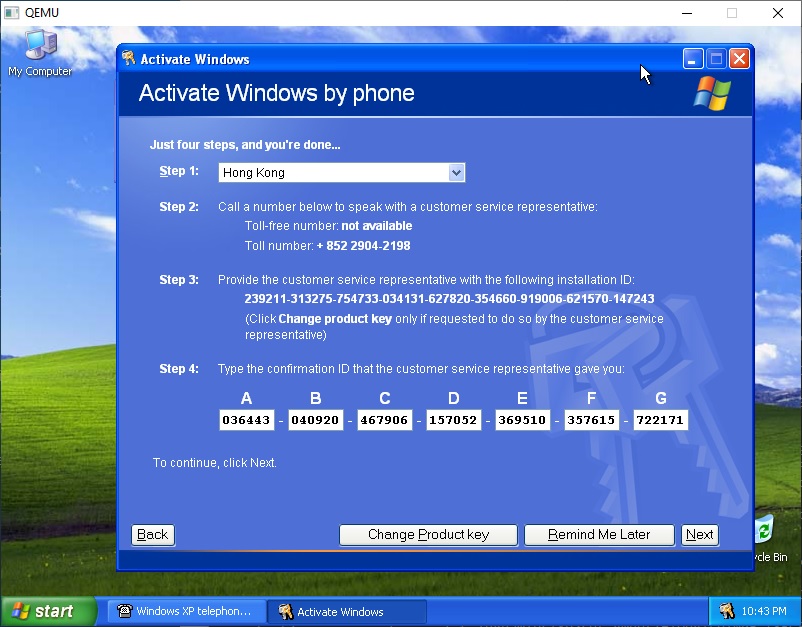
I did try to make a call, to activate my Windows, but the connection was terrible and I’m not even sure if these numbers were right. No I mean I know they didn’t work.
So I did what all legit users end up doing, using the crack for my 21 year old copy of Windows.
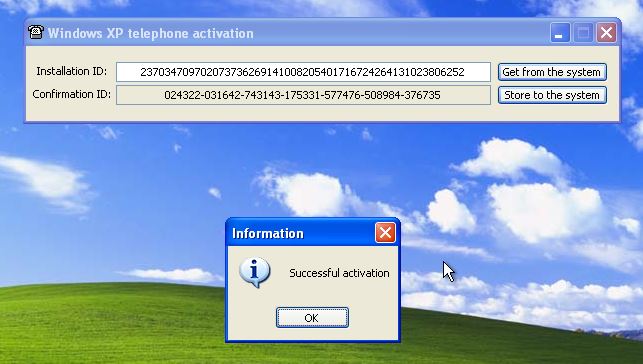
And just a few clicks later, it was done.
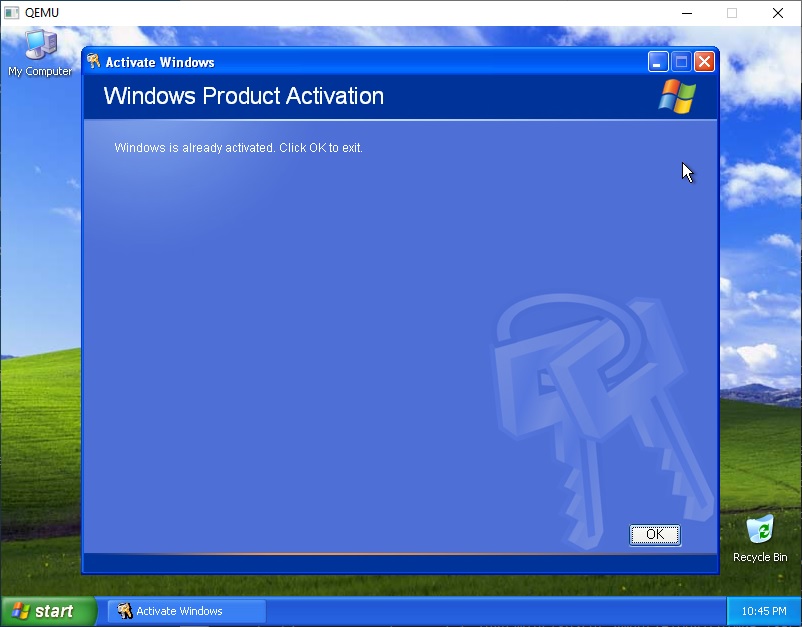
Windows XP Home is activated.
I don’t know if it’s even really going to last, I didn’t try anything else, actually I already deleted it. And the XP folio is back on the bookshelf.
Not only is there no DLC, did you know you can’t uninstall TCP/IP? At least you can unbind it from your NIC. While it does have IPX/SPX there is no built in Netware client. When they said HOME they meant it!
SIDs are really just another a fancy way of creating unique IDs in a decentralized way
A customer stumbled across a SID in an access control entry: S-1-15-3-1024-1365790099-2797813016-1714917928-519942599-2377126242-1094757716-3949770552-3596009590. They found the documentation on SIDs, which told them that given a SID of the form S-R-I-S..., the R is the revision ID, the I is the identifier authority value, and the S is a list of subauthorities. Applying this to the mystery SID told them that
- R = 1, this is a revision 1 SID.
- I = 15, the authority is 15.
- S = 3-1024-…, subauthorities.
The customer wanted to know what subauthorities this access control entry is granting access to. They couldn’t find this SID in the list of well-known SIDs.
Access control entries grant access to SIDs. They don’t grant access to subauthorities. The subauthority is the entity that issues the SID, but that doesn’t mean that the SID grants access to the subauthority.
Suppose you find a list of “Phone numbers which are allowed to call into this conference call.” Now, in many jurisdictions, there is some structure to telephone numbers that give you information about what kind of number it is and who issued it. You take one of those phone numbers, subject it to analysis, and conclude that the phone number was issued by Contoso Telecommunications. Does that mean that Contoso Telecommunications has access to your conference calls? No. All it tells you is that the phone that is allowed to call into your conference call was issued by Contoso Telecommunications. The power to join the conference call belongs to the phone number, not to the phone number’s issuer.
Similarly, when you grant access to a SID, you are granting access to anybody who possesses that SID in their token, but that doesn’t mean that that the subauthority which issued that SID is granted access. The subauthority is merely the entity that produced the SID. Once they generate it, they don’t have any more power over that SID than anybody else.
But really, all this authority/subauthority nonsense is beside the point. The use of authorities and subauthorities is an implementation detail of SIDs.
The point of SIDs is that they are a unique ID to identify an entity that can be granted (or denied) access.
It so happens that authorities and subauthorities are a mechanism for how the system ensures that no two SIDs are the same. But that’s not really relevant to what SIDs are used for, which is to identify entities which can be granted access. What authorities and subauthorities do is allow entities to carve up the SID space and say, “Okay, I’m going to let you create new SIDs in this little corner of the SID namespace. That corner is all yours. Create SIDs there any way you like.”
Let’s go back to the SID that this customer is trying to understand.
We see that the SID begins S-1-15-3-1024-…, and if you look in winnt.h, you can see that authority 15 is assigned to SECURITY_ subauthority 3 is assigned to SECURITY_, and sub-subauthority 1024 is assigned to SECURITY_. If you have a good memory, you may recall that I discussed this corner of the SID space in the past. These SIDs are app capability SIDs, and the numbers that come after the 1024 are the decimal representation of eight 32-bit values that together form the SHA256 hash of the capability name.
Bonus chatter: One commenter noted that it would be great if Process Explorer could resolve these hash-based capability SIDs into the original name. Since these are SHA256 hashes, you cannot reasonably expect Process Explorer (or anybody else) to be able to recover the original name from an arbitrary hash. If you could do that, you would use that power to do much more lucrative things than recovering app capability names! At best, Process Explorer could have a hard-coded list of app capability SIDs and their corresponding capability names. But that list is never going to be comprehensive because anybody can make up a new one by calling DeriveCapabilitySidsFromName.
The post SIDs are really just another a fancy way of creating unique IDs in a decentralized way appeared first on The Old New Thing.
Best AM5 motherboards in 2024
AMD's Ryzen 7000 series of processors make use of the company's newer AM5 socket, replacing the older AM4 socket used by the first wave of Ryzen chips. Utilizing the best DDR5 RAM, PCIe 5.0, and USB 4.0, there's plenty to appreciate with the 7000 series of processors. When shopping around for an AM5 motherboard, there are a few chipsets to choose from. I'll showcase some of the best motherboards available for AMD chips to aid you in building the PC of your dreams.
If you're regularly getting ambushed by pods of killer whales, you probably did something to piss them off [Strange]
Jurassic Park's Paleontologist Adviser May Have Inspired Its Main Character

House of Representatives To Hold Hearing On Whistleblower's UFO Claims
Read more of this story at Slashdot.
ChatGPT Makes False Accusations Against Radio Host, Resulting In A Defamation Lawsuit Against OpenAI

Irrespective of how simple ChatGPT has made lives for millions of people when they want quick answers to queries in seconds, it cannot be ignored that the Large Language Model (LLM) would make glaring errors that were both false and misleading. Unfortunately for OpenAI, the entity behind ChatGPT’s creation, those errors have landed the company in hot waters thanks to a lawsuit filed by a radio host.
Radio host has filed a defamation lawsuit against OpenAI as ChatGPT generated answers related to the host’s history of crimes, which ended up being false
Mark Walters, a radio host in Georgia, is suing OpenAI because ChatGPT made responses that the host had been accused of defrauding and embezzling funds from a non-profit organization. According to The Verge, the LLM generated the information after receiving an inquiry from a journalist named Fred Riehl. The lawsuit was filed on June 5 in Georgia’s Superior Court of Gwinnett County, with Walters seeking monetary compensation from OpenAI of an undisclosed amount.
The journalist received the responses from ChatGPT after it asked the program to summarize a real federal court case by linking to an online PDF. The Large Language Model then generated a false summary of the case, which has extensive in detail but was also false. It mentioned incorrect information that Mark Walters was believed to have pursued the misappropriation of funds from a gun rights non-profit called the Second Amendment Foundation, where Walters pocketed $5 million. Nowhere has it been stated that Walters was accused of this crime.
Fred Riehl, the journalist, made the responsible choice not to publish this factually incorrect information. Instead, he decided to double down on the information through another source, which was the correct decision to make. However, the reports do not confirm how Mark Walters figured out that ChatGPT was generating false responses about him. Since millions of users are aware that such programs would often make misleading responses, which are often referred to as ‘hallucinations,’ they would outright dismiss them without a second thought.
However, when ChatGPT starts generating responses that can result in actual harm, then it becomes a problem. Two instances where the LLM’s responses led to severe consequences was when one professor threatened to fail his entire class after ChatGPT stated that students were using AI to complete their essays. The second incident revolved around a lawyer facing possible disbarring after using the program to research fake legal cases. Due to these issues and more, OpenAI has issued a small disclaimer on ChatGPT’s homepage, warning users that the AI can occasionally generate false information.
It is unclear how this lawsuit will play out, but it is high time that OpenAI engineers attempt to alleviate the false responses generated by ChatGPT because more trouble can ensue for various professionals, including the company.
GPU Shipments Continued To Decline In Q1 2023: NVIDIA at 84%, AMD at 12%, Intel at 4% Market Share

Jon Peddie Research has just published the GPU market share results for Q1 2024 which show a big decline in shipments for NVIDIA, AMD & Intel.
GPU Market Slows Down, Hits Lowest Shipments In Over Two Decades: NVIDIA Retains Top Spot With 84% Share
According to the report, the overall GPU AIB market saw shipments decline by -12.6% versus the previous quarter and -38.2% versus the previous year. The attach rate did grow by a slight margin of 8% but compared to the previous year, that too declined by -21%. In terms of numbers, the AIBs shipped 6.3 million discrete graphics cards in the first quarter of 2023.
Quick Highlights
- JPR found that AIB shipments during the quarter decreased from the last quarter by 12.6%, which is below the 10-year average of -4.9%.
- Total AIB shipments decreased by -38.2% this quarter from last year to 6.3 million units and were down from 7.16 million units last quarter.
- AMD’s quarter-to-quarter total desktop AIB unit shipments decreased -by 7.5%.
- Nvidia’s quarter-to-quarter unit shipments decreased -15.2%. Nvidia continues to hold a dominant market share position at 83.7%.
- AIB shipments from year to year decreased by -38.2% compared to last year.

In terms of market share, NVIDIA's market share dropped to 84% but still retains the market leadership. Meanwhile, AMD's market share remained flat at 12% while Intel's market share saw growth to 4%.
“Shipments of new AIBs were impacted by turndown in the PC market due to inflation worries and layoffs, and people buying last-gen boards as suppliers sought to reduce inventory levels. With inventory being run down, sales of new-generation boards will pick up, but not until Q3. Q2 is traditionally a down quarter, and the year won’t be any different, but probably not as severe as might be expected,” said Jon Peddie, JPR founder and president.
JPR has been tracking AIB shipments quarterly since 1987—the volume of those boards peaked in 1998, reaching 116 million units. Since Q1 2000, over 2.13 billion AIBs, worth about $490 billion, have been sold.
JPR points to this market outlook as a course correction and expects that the second half of this year will be much better since all vendors will have more affordable and mainstream options available for its consumers. NVIDIA recently introduced its GeForce RTX 4060 series graphics cards and has more affordable variants coming out in July. AMD also introduced the Radeon RX 7600 and has more options coming out too.
Meanwhile, both NVIDIA and AMD have older inventory that can be used to attract gamers in the mainstream and budget segment. Intel on the other hand is very active in the consumer segment and has some of the best performance/$ options available at the moment. The company has price dropped its Arc A750 offerings which can be found for as low as $199 US while the 16 GB Arc A770 is currently the most affordable 16 GB option under $300 US.
Although new graphics cards have been launched, consumers have shown little to no interest in them due to the obviously bad price-to-performance ratio. GPU vendors, especially NVIDIA, saw a big uptick in the prices this generation and while Ada's features and efficiency remain unrivaled, the graphics cards do cost a lot. At the same time, the mainstream RTX 4060 Ti and RTX 4060 are priced the same or lower than their predecessors but the performance gains aren't as significant when we look at something like the RTX 4090 and how its achieves over 50% uplift over the 3090s.
- NVIDIA
- AMD
- Intel
More Steam users are flocking to Windows 11

Despite a bumpy ride during its 19-month lifespan, things are really starting to look up for Windows 11. Microsoft’s OS is getting more and more popular with Steam users all the time, and the operating system has just achieved a new gaming PC adoption milestone. Is 2023 the year Windows 11 finally gains mass adoption?
Apple's New Proton-like Tool Can Run Windows Games on a Mac
Read more of this story at Slashdot.
No Man’s Sky 10th Expedition, Singularity, Is Out Now with a Much Longer Narrative Arc

UK developer Hello Games continues to surprise on a regular basis when it comes to the cadence of No Man's Sky updates.
Just a few days ago, the studio launched the native MacOS version of the game. Today, the studio announced the release of the tenth No Man's Sky Expedition, which they reckon is completely different from the previous ones.
Called Singularity, it'll focus on AI corruption and robotic uprisings, which Hello Games admits is a topic strangely absent from a sci-fi game up to this point. The developers said Singularity would evolve over a much longer narrative arc of five weeks. It'll begin with players investigating 'robot heads' that are dropping clues throughout the galaxy.
They'll collaborate with Polo and Nada to discover what's behind this space anomaly. Additionally, players will be making a choice at the end of the Singularity Expedition, and the decision will have consequences that will develop in the future of No Man's Sky story. Of course, participating in the Expedition will unlock many cool rewards, such as a new robotic character customization set.

No Man's Sky was hugely hyped before launch, only to provoke disappointment on day one in both critics and fans. At some point, the game was even investigated by the United Kingdom's advertising authorities for potential false advertising. However, the folks at Hello Games rolled up their proverbial sleeves and kept pumping new features and content at an incredible pace.
The game is now completely VR compatible, supports various upscalers (DLSS, FSR 2, etc.) on PC, is out on Nintendo Switch (with cross-play), not to mention the many gameplay features and mechanics introduced in the last six years or so. It doesn't look like Hello Games will be done adding more to No Man's Sky any time soon, either, even though the studio is also working on a new ambitious secret project, as revealed in September 2020 by studio founder Sean Murray.
Two homes damaged in Smokey Point fire. I'd make a joke, but my house in Watery Point just flooded [Scary]
The Outer Worlds: Spacer’s Choice Edition Patch 1.3 aims to reduce shader compilation and traversal stutters
Last week, Private Division and Virtuos Games released a brand new update for The Outer Worlds: Spacer’s Choice Edition. According to the release notes, Update 1.3 aims to reduce both shader compilation and traversal stutters. Going into more details, Patch 1.3 brings PSO cache improvements to fix hitching issues on PC. Moreover, it updates environment … Continue reading The Outer Worlds: Spacer’s Choice Edition Patch 1.3 aims to reduce shader compilation and traversal stutters →
The post The Outer Worlds: Spacer’s Choice Edition Patch 1.3 aims to reduce shader compilation and traversal stutters appeared first on DSOGaming.
White House Quiet on National Cyber Director Choice, Senator Says
Read more of this story at Slashdot.
You die and your kin just dump your PC at some thrift store. Nobody wipes the hard drive. What will the buyer find? Here, they found "the Library of Alexandria" of gay porn DVD reviews. And some sentimental stuff, hence tag. And stickiness [Sappy]
Sony Chief Warns Technical Problems Persist for Cloud Gaming
Read more of this story at Slashdot.
Apple Announces macOS Sonoma with Desktop Widgets, Game Mod, and Much, Much More

Apple has finally announced the latest macOS Sonama. This is a supercharged update for the Mac operating system. Sonama will launch later this year in the fall and will be bringing a number of top-tier features, such as the ability to place widgets on the desktop. You are also getting aerial screensavers, something that you often see on Apple TV. With the new update, Apple is also focusing on making iMessage better for everyone, and last but not least, Game Mode is also coming to the new OS, and for those wondering, it works by ensuring that the game you are playing gets the most access to the resources so you do not run into hiccups while gaming.
The macOS Sonoma is also going ot bring a number of improvements to Safari. You will be able to have a Profiles feature that will allow you to have a separate work and personal account, something that you have seen on Google Chrome. In addition to that, Mac finally supports web apps, which would simply allow the websites such as Facebook, Twitter, Spotify, Instagram, and more to appear as apps on the Dock, making it super easy for everyone to just go ahead and access the apps and websites they want.
Updating...
New DirectX 12-To-Metal Translation Could Bring a World of Windows Games To macOS
Read more of this story at Slashdot.
Apple Announces macOS Sonoma With Desktop Widgets and Game Mode
Read more of this story at Slashdot.
Xbox FTC Settlement and Reimagining the Future of Safety on Xbox
At Xbox, we have the fundamental commitment to provide all players with a safe and secure experience on our platform – and this is especially true for our youngest players. We frequently iterate on our safety measures, in collaboration and with feedback from the community, regulators and partners. We recently entered into a settlement with the U.S. Federal Trade Commission (FTC) to update our account creation process and resolve a data retention glitch found in our system. Regrettably, we did not meet customer expectations and are committed to complying with the order to continue improving upon our safety measures. We believe that we can and should do more, and we’ll remain steadfast in our commitment to safety, privacy, and security for our community.
Our two decades of safety experience has taught us that all players want, and need, safety and privacy protections. Since 2005, when we launched the first console that could connect players online, we’ve continued to invest in tools and technologies to protect our community. That work evolved into a multifaceted safety strategy. Our suite of safety, privacy and security measures are designed to respect player privacy and safety, and empower players, as well as parents and caregivers, to have control over their gaming experiences.
Below we detail the changes we made to verify child accounts, however, our work on age validation doesn’t stop there. We see an opportunity to further advance safe digital experiences that are accessible, simple to use, and benefit all players. We are innovating on next-generation identity and age validation – a convenient, secure, one-time process for all players that will allow us to better deliver customized, safe, age-appropriate experiences. The long-term benefits will be felt by all players, especially children and their families. And while we see this as the future, we anticipate that the entire games industry will as well.
Over the coming months, we will test new methods to validate age and take feedback from our customers’ experience. The learnings from these trials will directly inform advancements in our player identity systems. We are incorporating Microsoft’s insights from across industries to develop a principled approach to secure digital identities that minimizes data collection, prioritizes security, and makes it easier for players to understand how their data is used.
We’ll continue to put players at the center – giving them full control over their online experiences and digital identities. We’ll continue to empower parents and caregivers to exercise appropriate oversight of the gaming experience for their children and families, in addition to tools like the Xbox Family Settings App and child accounts. Child accounts are built for underage players so that parents and caregivers can manage settings, privacy, spending and more. We will continue to be transparent and clear about the actions we take on our service, just as we did when we released our inaugural Transparency Report and second Transparency Report in May.
The Xbox community is our community – one we shape together. As we innovate and trial new experiences, we’ll work with the community to gather feedback so we can create a safer gaming experience together.
What the FTC settlement means for players
Since the FTC settlement, we have updated our account creation process, which now requires players to first identify date-of-birth and, if under 13 years old, obtain verified parental consent before providing us with any information such as phone number or email address. This updated process ensures that we can identify potential child accounts immediately and make clear to parents and caregivers the next steps to protect their children’s data and play safely on our network.
Over the coming months, players who are under the age of 13 and created an account prior to May 2021 will require parental reconsent – meaning a parent will be prompted to reverify the account and grant permission for their child to continue gameplay and activity on Xbox. We are committed to making this process as seamless as possible. We are working hard to ensure that when parents are prompted to reconsent, they will have the information needed to proceed without disruptions to their child’s access. To learn more about setting up a child account, please visit here.
During the investigation, we identified a technical glitch where our systems did not delete account creation data for child accounts where the account creation process was started but not completed. This was inconsistent with our policy to save that information for only 14 days to make it easier for gamers to pick up where they left off to complete the process. Our engineering team took immediate action: we fixed the glitch, deleted the data, and implemented practices to prevent the error from recurring. The data was never used, shared, or monetized.
To more clearly explain what information we collect and how we use it, we updated our Microsoft Privacy Statement, including a dedicated section about how Xbox processes user data. We have also updated our home screen to have a clearly labelled link to the Microsoft Privacy Statement. This link also appears in each area of the service where personal information is collected. Microsoft also provides a privacy dashboard that shares with families what data is collected and used. Players can adjust their privacy settings at any time and child accounts are set to the strongest privacy settings by default. To learn more about Xbox’s privacy features, please visit here.
Additional resources for families
We want all parents, caregivers, and families to know that, more than anything else, we have their children’s safety and privacy top of mind. We will continue to communicate the changes we are making to our practices and the data we collect so we can better protect children using our platform. We also continue to explore creative ways to educate players about online safety.
This past Safer Internet Day, we released Minecraft’s Privacy Prodigy, aimed at teaching young people about privacy and how to safeguard their sensitive personal information. This world is the second chapter in the CyberSafe series, following last year’s release of Minecraft CyberSafe: Home Sweet Hmm, reaching millions of players, with unprecedented downloads of support materials underscoring the demand by teachers and families to teach these critical skills and integrate safer online practices daily. CyberSafe: Home Sweet Hmm and CyberSafe: Privacy Prodigy are both available for free on Minecraft: Education Edition and Minecraft Bedrock.
Our updated Xbox Family Hub shares information about creating a family group, managing child accounts, and helps parents and caregivers understand the safety measures we have in place, such as the Xbox Family Settings App.
For more information on Microsoft privacy, safety, and responsible gaming, please see the below list of resources:
Related:Xbox Releases Second Transparency Report Demonstrating the Integral Role of Proactive Content Moderation
Xbox Celebrates Safer Internet Day with Minecraft’s New Privacy-Themed Learning World and Safety Tips for Parents
Xbox Shares Community Safety Approach in Transparency Report



